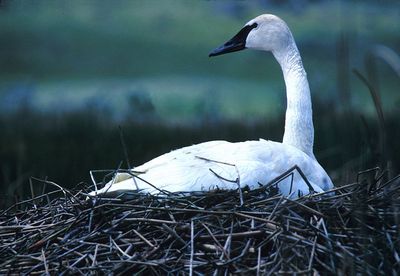A Fly can’t bird, but a bird can fly.
An A A Milne Quotation

Trumpeter Swan: Have you seen this bird?
Trumpeter Swan
The Trumpeter Swan, Cygnus buccinator, is the largest native North American bird. If measured in terms of weight and length, then it is (on average) the largest living waterfowl species on earth.
Their breeding habitat is large shallow ponds and wide slow rivers in northwestern and central North America, with the largest numbers of breeding pairs found in Alaska.
Identification Tips:
• Length: 45 inches Wingspan: 95 inches
• Large, long-necked waterbird with short legs and a short duck-like bill
• Long neck held straight up with a kink at base
Adult:
• Black bill
• Culmen straight
• Black of bill extends up to eye but does not encircle it
• V shaped demarcation on forehead between black bill and white feathering
• Black legs and feet
• Entirely white plumage
• Sexes similar
Similar species:
The very large Trumpeter Swan is unlikely to be confused with anything but other swans. White Pelicans, Whooping Cranes, Wood Storks, and Snow Geese are all white birds that from a great distance could look like swans but all have black primaries. The adult Mute Swan can be told from the adult Trumpeter Swan by its orange and black knobby bill.
These swans feed while swimming. Sometimes they end up up-ending or dabbling to reach submerged food. The Trumpeter Swans’ diet is almost entirely aquatic plants. In winter, they may also eat grasses and grains in fields.
The young are fed on insects and small crustaceans along with plants at first, changing to a vegetation-based diet over the first few months.
The female lays 3-10 eggs on average in a mound of plant material on a small island, a beaver or muskrat lodge, or a floating platform. The same location may be used for several years.
Natural populations of these swans migrate to and from the Pacific coast and portions of the United States, flying in V-shaped flocks. Released populations are mostly non-migratory.
A Fly can’t bird, but a bird can fly. An A A Milne Quotation
Bird Quotation Popularity Poll
(4 answers max)
 Loading ...
Loading ...
Add any comments below and/or indicate if you spotted this bird.
A Fly can’t bird, but a bird can fly.
Bird Quote Notice
Please submit bird quotes, or your own bird quote. Enter the bird quote for others to enjoy by filling out the Submit form on the menu.









Great to see Trumpeter Swans featured on your Blog. I hope you and your readers will check out http://www.trumpeterswansociety.org where we have some great i.d. tips on identifying swans with an emphasis on Trumpeter – Tundra comparisons. We also have some great information on the restoration efforts, migratory flyways and current news. The mission of The Trumpeter Swan Society (TTSS) is to assure the vitality and welfare of wild Trumpeter Swans. We focus on issues of habitat, restoring populations and toxicity from lead. Thank you for drawing attention to this icon of wild America!
Peg Abbott, Outreach Coordinator, The Trumpeter Swan Society